Management Accounting Report: Krishnamurti Pty Ltd Case Study Analysis
VerifiedAdded on 2021/06/17
|12
|1259
|64
Report
AI Summary
This report analyzes a management accounting case study for Krishnamurti Pty Ltd, focusing on the production of AC/DC switches. The report examines the preparation of budgets, including sales, production, direct labor, purchase, and cash budgets. It evaluates a new production plan, highlighting the impact on costs and revenues. The analysis includes a master budgeting approach and assesses the viability of the production plan. Furthermore, the report differentiates between participative and imposed budgets, advocating for a participative approach in the case study to facilitate collaborative decision-making and improve cash flow management. The report concludes with a list of references used in the analysis.
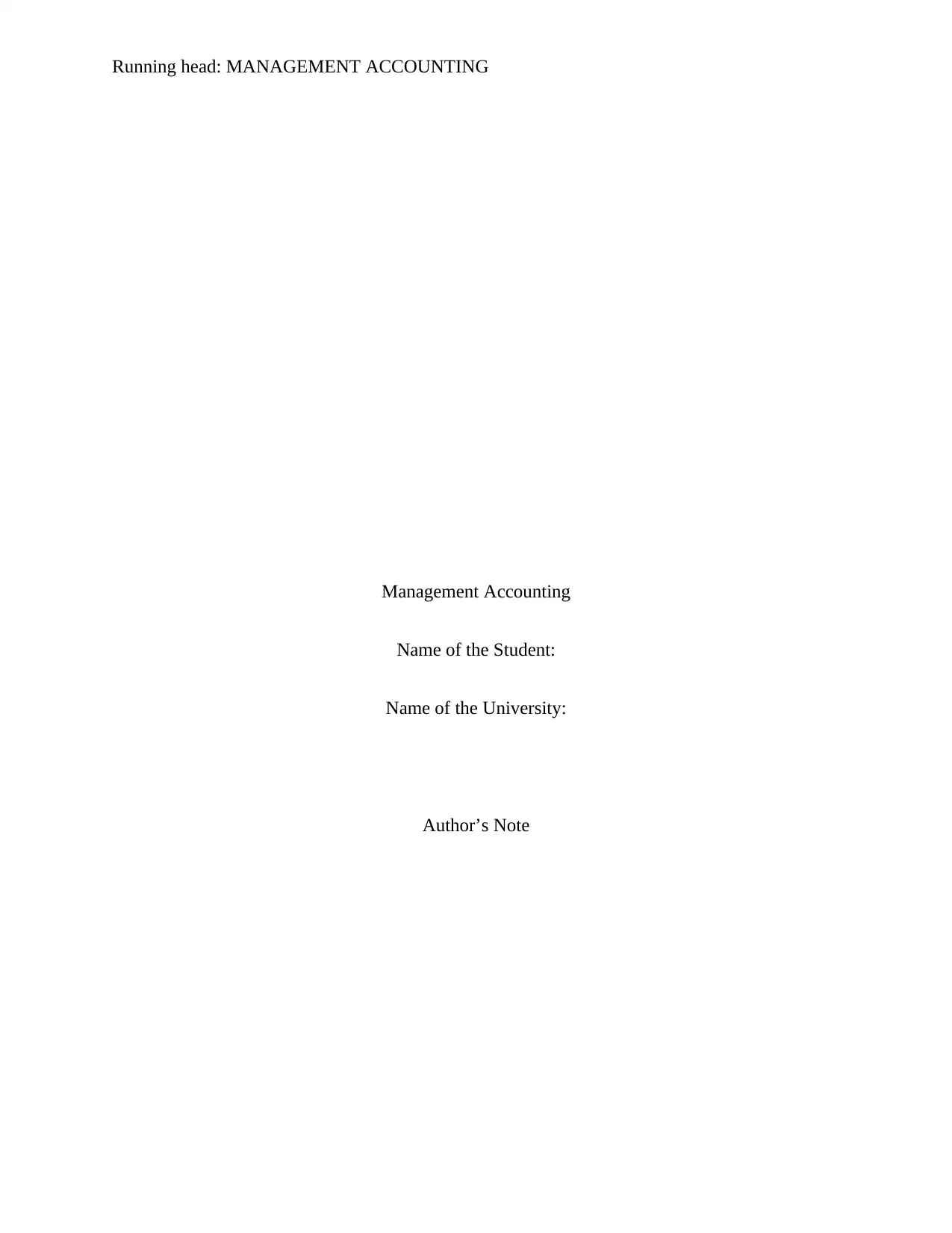
Running head: MANAGEMENT ACCOUNTING
Management Accounting
Name of the Student:
Name of the University:
Author’s Note
Management Accounting
Name of the Student:
Name of the University:
Author’s Note
Paraphrase This Document
Need a fresh take? Get an instant paraphrase of this document with our AI Paraphraser
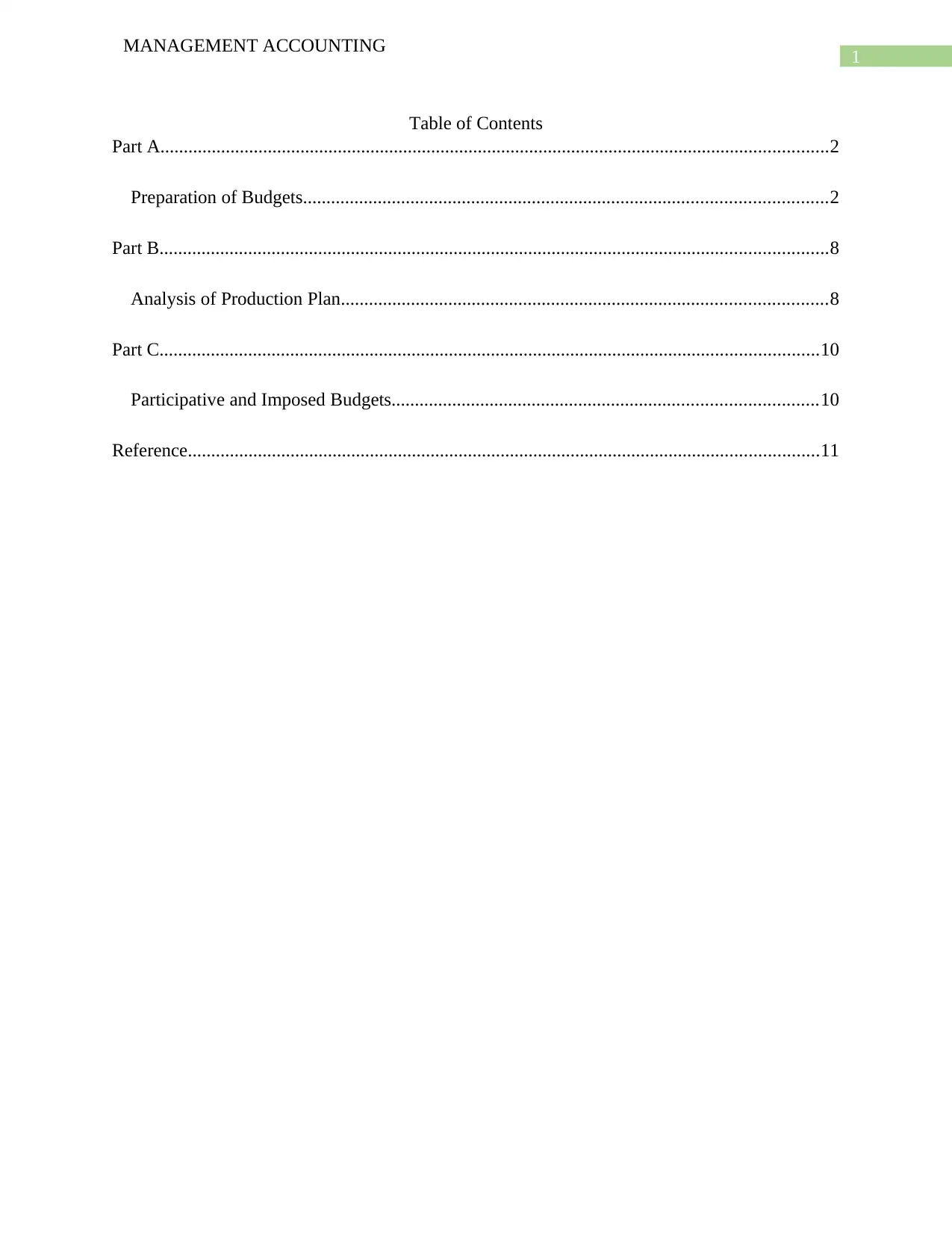
1
MANAGEMENT ACCOUNTING
Table of Contents
Part A...............................................................................................................................................2
Preparation of Budgets................................................................................................................2
Part B...............................................................................................................................................8
Analysis of Production Plan........................................................................................................8
Part C.............................................................................................................................................10
Participative and Imposed Budgets...........................................................................................10
Reference.......................................................................................................................................11
MANAGEMENT ACCOUNTING
Table of Contents
Part A...............................................................................................................................................2
Preparation of Budgets................................................................................................................2
Part B...............................................................................................................................................8
Analysis of Production Plan........................................................................................................8
Part C.............................................................................................................................................10
Participative and Imposed Budgets...........................................................................................10
Reference.......................................................................................................................................11
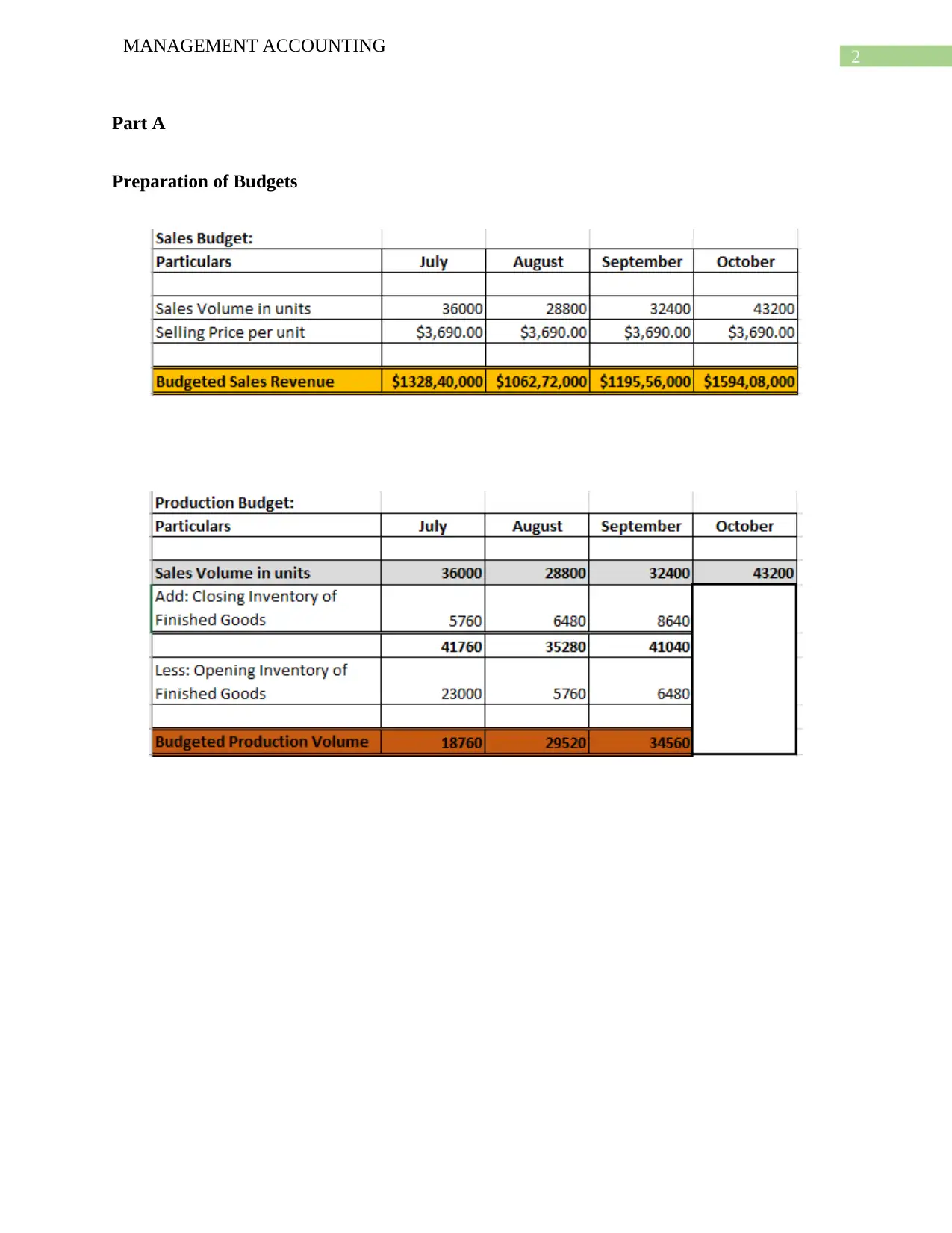
2
MANAGEMENT ACCOUNTING
Part A
Preparation of Budgets
MANAGEMENT ACCOUNTING
Part A
Preparation of Budgets
⊘ This is a preview!⊘
Do you want full access?
Subscribe today to unlock all pages.

Trusted by 1+ million students worldwide
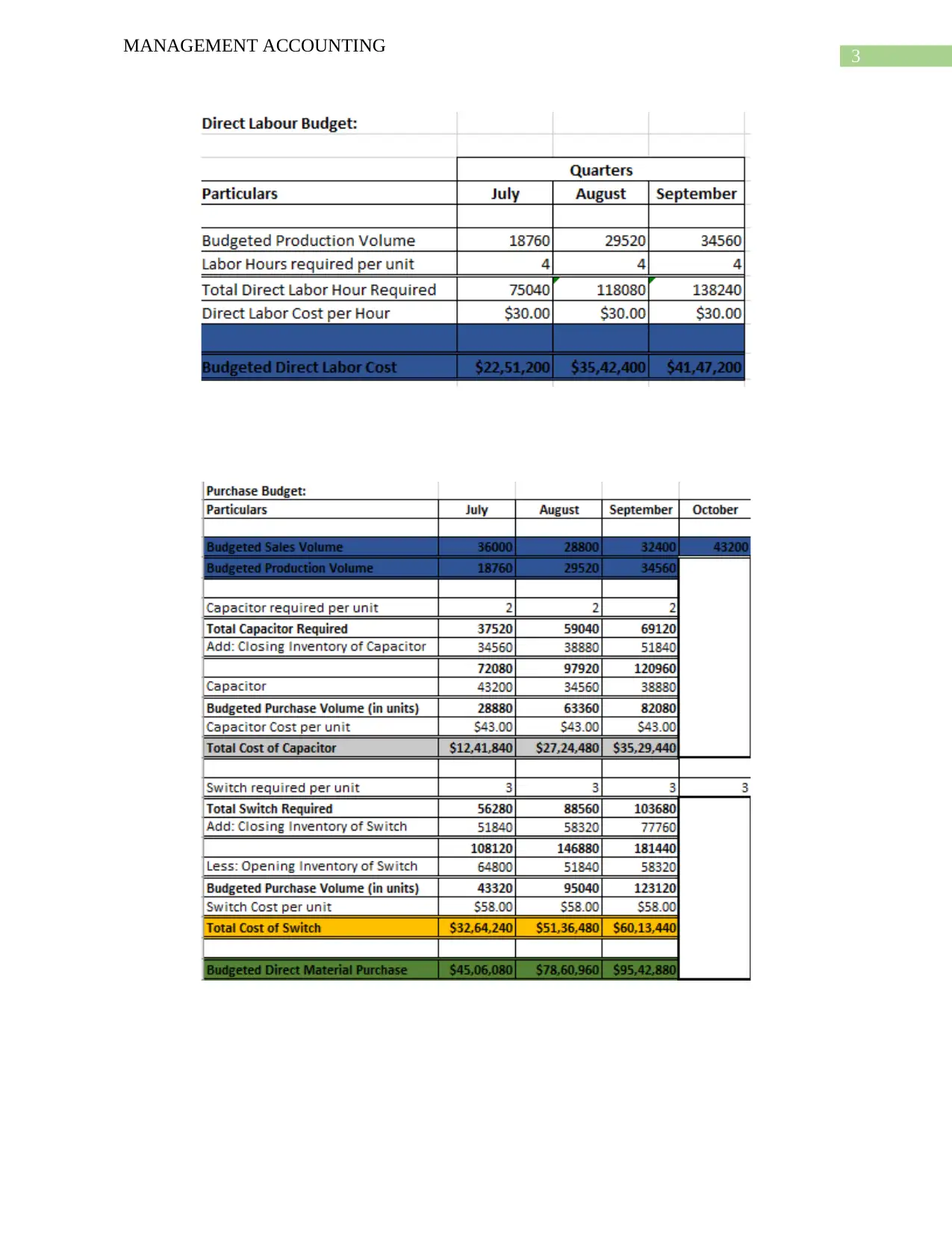
3
MANAGEMENT ACCOUNTING
MANAGEMENT ACCOUNTING
Paraphrase This Document
Need a fresh take? Get an instant paraphrase of this document with our AI Paraphraser
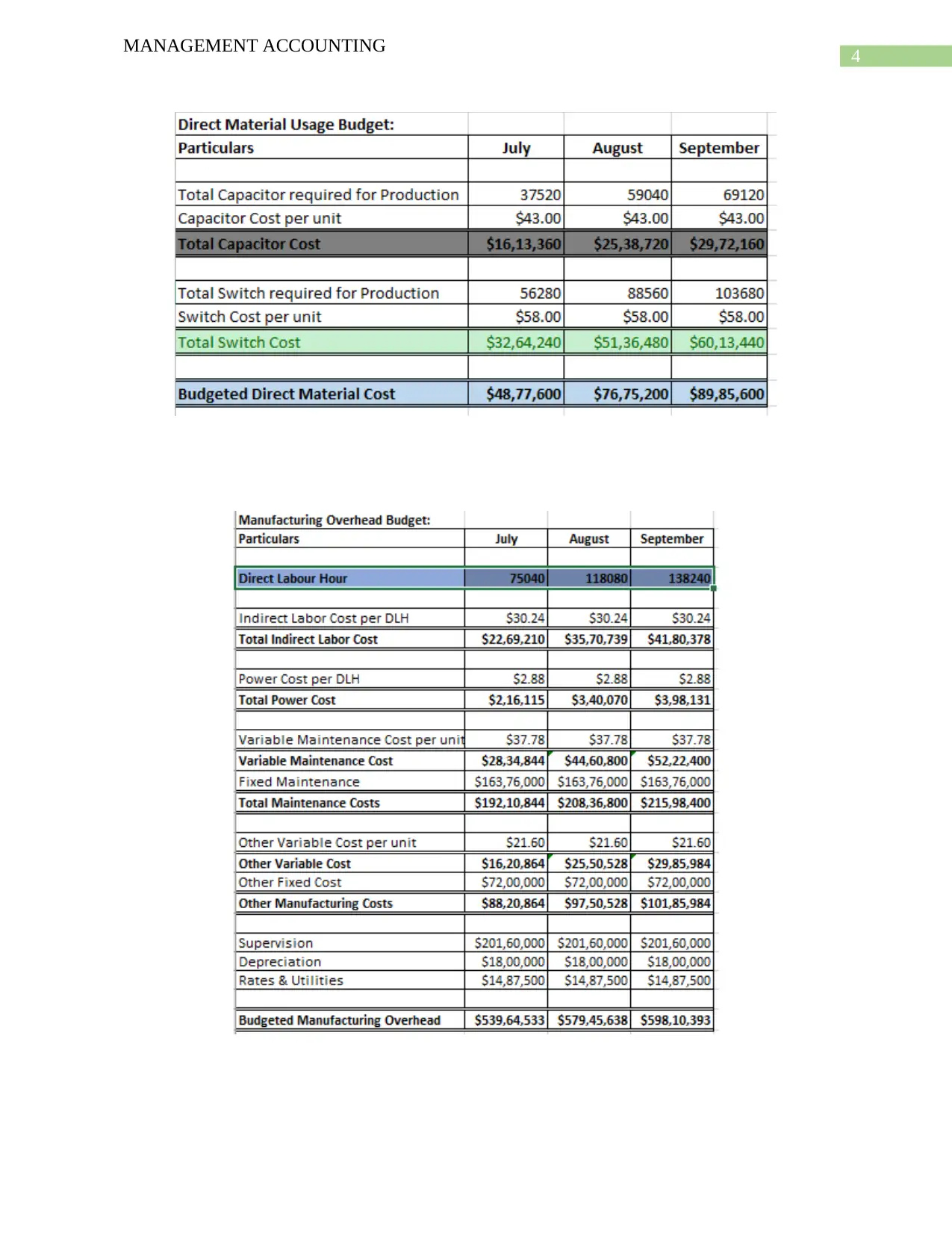
4
MANAGEMENT ACCOUNTING
MANAGEMENT ACCOUNTING
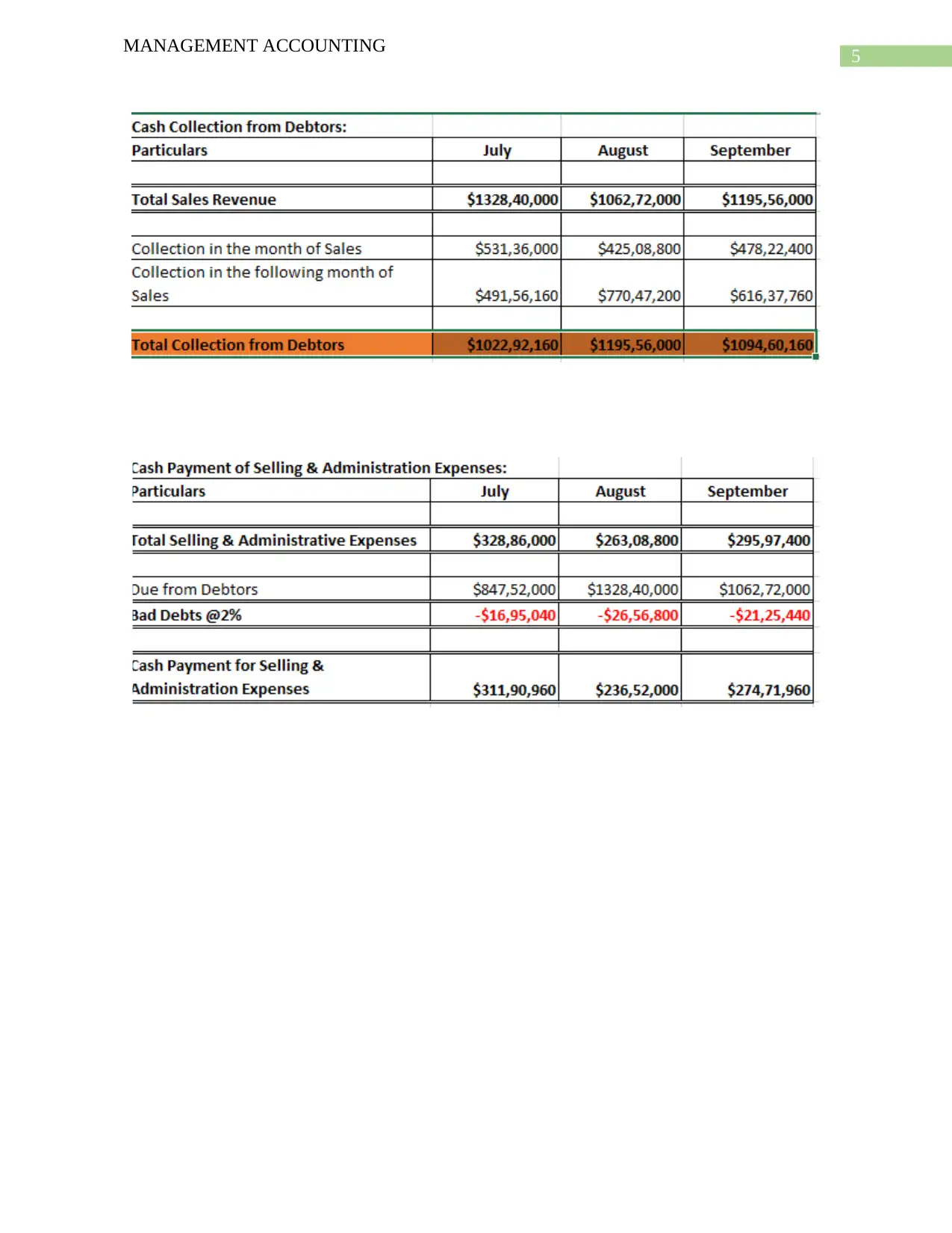
5
MANAGEMENT ACCOUNTING
MANAGEMENT ACCOUNTING
⊘ This is a preview!⊘
Do you want full access?
Subscribe today to unlock all pages.

Trusted by 1+ million students worldwide
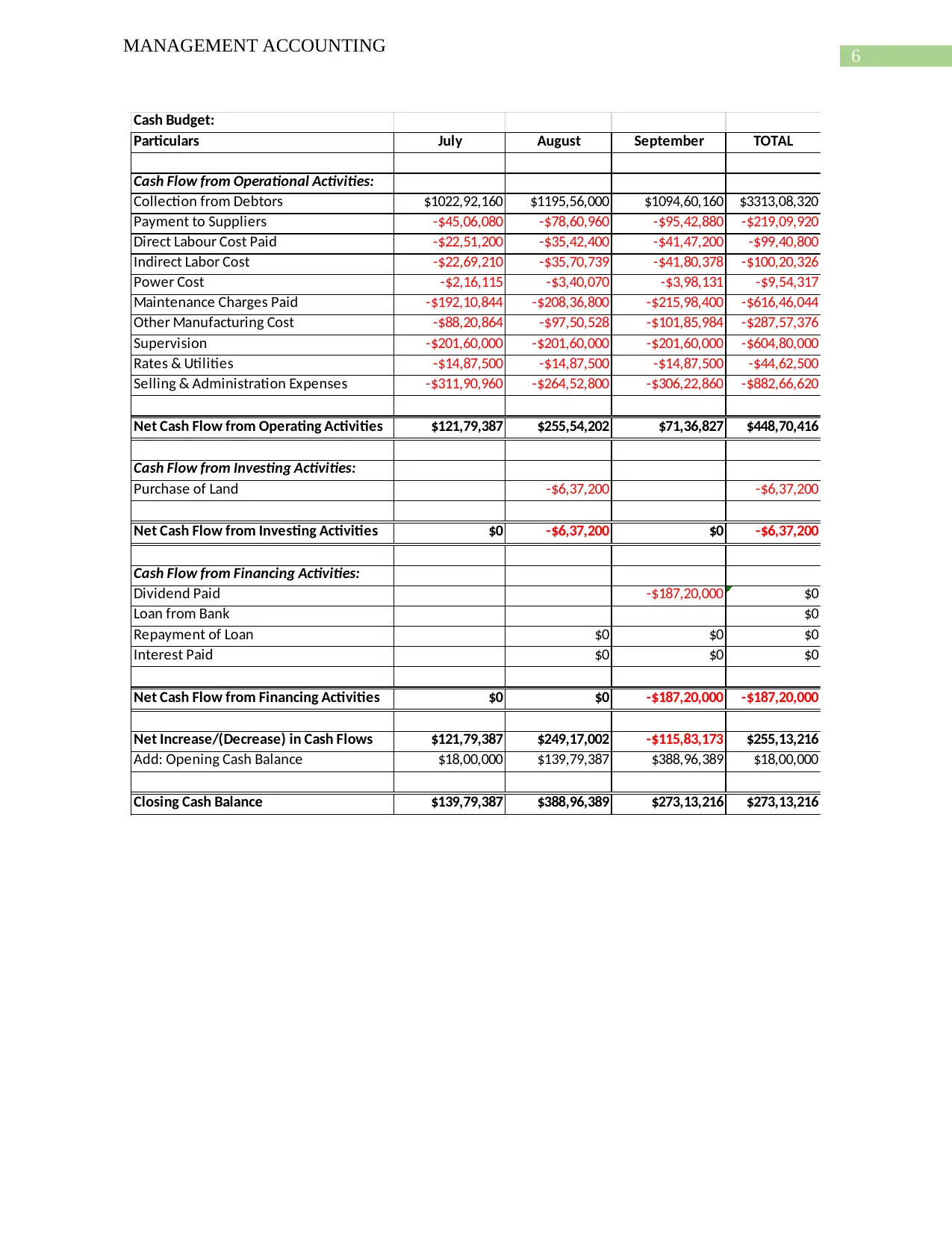
6
MANAGEMENT ACCOUNTING
Cash Budget:
Particulars July August September TOTAL
Cash Flow from Operational Activities:
Collection from Debtors $1022,92,160 $1195,56,000 $1094,60,160 $3313,08,320
Payment to Suppliers -$45,06,080 -$78,60,960 -$95,42,880 -$219,09,920
Direct Labour Cost Paid -$22,51,200 -$35,42,400 -$41,47,200 -$99,40,800
Indirect Labor Cost -$22,69,210 -$35,70,739 -$41,80,378 -$100,20,326
Power Cost -$2,16,115 -$3,40,070 -$3,98,131 -$9,54,317
Maintenance Charges Paid -$192,10,844 -$208,36,800 -$215,98,400 -$616,46,044
Other Manufacturing Cost -$88,20,864 -$97,50,528 -$101,85,984 -$287,57,376
Supervision -$201,60,000 -$201,60,000 -$201,60,000 -$604,80,000
Rates & Utilities -$14,87,500 -$14,87,500 -$14,87,500 -$44,62,500
Selling & Administration Expenses -$311,90,960 -$264,52,800 -$306,22,860 -$882,66,620
Net Cash Flow from Operating Activities $121,79,387 $255,54,202 $71,36,827 $448,70,416
Cash Flow from Investing Activities:
Purchase of Land -$6,37,200 -$6,37,200
Net Cash Flow from Investing Activities $0 -$6,37,200 $0 -$6,37,200
Cash Flow from Financing Activities:
Dividend Paid -$187,20,000 $0
Loan from Bank $0
Repayment of Loan $0 $0 $0
Interest Paid $0 $0 $0
Net Cash Flow from Financing Activities $0 $0 -$187,20,000 -$187,20,000
Net Increase/(Decrease) in Cash Flows $121,79,387 $249,17,002 -$115,83,173 $255,13,216
Add: Opening Cash Balance $18,00,000 $139,79,387 $388,96,389 $18,00,000
Closing Cash Balance $139,79,387 $388,96,389 $273,13,216 $273,13,216
MANAGEMENT ACCOUNTING
Cash Budget:
Particulars July August September TOTAL
Cash Flow from Operational Activities:
Collection from Debtors $1022,92,160 $1195,56,000 $1094,60,160 $3313,08,320
Payment to Suppliers -$45,06,080 -$78,60,960 -$95,42,880 -$219,09,920
Direct Labour Cost Paid -$22,51,200 -$35,42,400 -$41,47,200 -$99,40,800
Indirect Labor Cost -$22,69,210 -$35,70,739 -$41,80,378 -$100,20,326
Power Cost -$2,16,115 -$3,40,070 -$3,98,131 -$9,54,317
Maintenance Charges Paid -$192,10,844 -$208,36,800 -$215,98,400 -$616,46,044
Other Manufacturing Cost -$88,20,864 -$97,50,528 -$101,85,984 -$287,57,376
Supervision -$201,60,000 -$201,60,000 -$201,60,000 -$604,80,000
Rates & Utilities -$14,87,500 -$14,87,500 -$14,87,500 -$44,62,500
Selling & Administration Expenses -$311,90,960 -$264,52,800 -$306,22,860 -$882,66,620
Net Cash Flow from Operating Activities $121,79,387 $255,54,202 $71,36,827 $448,70,416
Cash Flow from Investing Activities:
Purchase of Land -$6,37,200 -$6,37,200
Net Cash Flow from Investing Activities $0 -$6,37,200 $0 -$6,37,200
Cash Flow from Financing Activities:
Dividend Paid -$187,20,000 $0
Loan from Bank $0
Repayment of Loan $0 $0 $0
Interest Paid $0 $0 $0
Net Cash Flow from Financing Activities $0 $0 -$187,20,000 -$187,20,000
Net Increase/(Decrease) in Cash Flows $121,79,387 $249,17,002 -$115,83,173 $255,13,216
Add: Opening Cash Balance $18,00,000 $139,79,387 $388,96,389 $18,00,000
Closing Cash Balance $139,79,387 $388,96,389 $273,13,216 $273,13,216
Paraphrase This Document
Need a fresh take? Get an instant paraphrase of this document with our AI Paraphraser
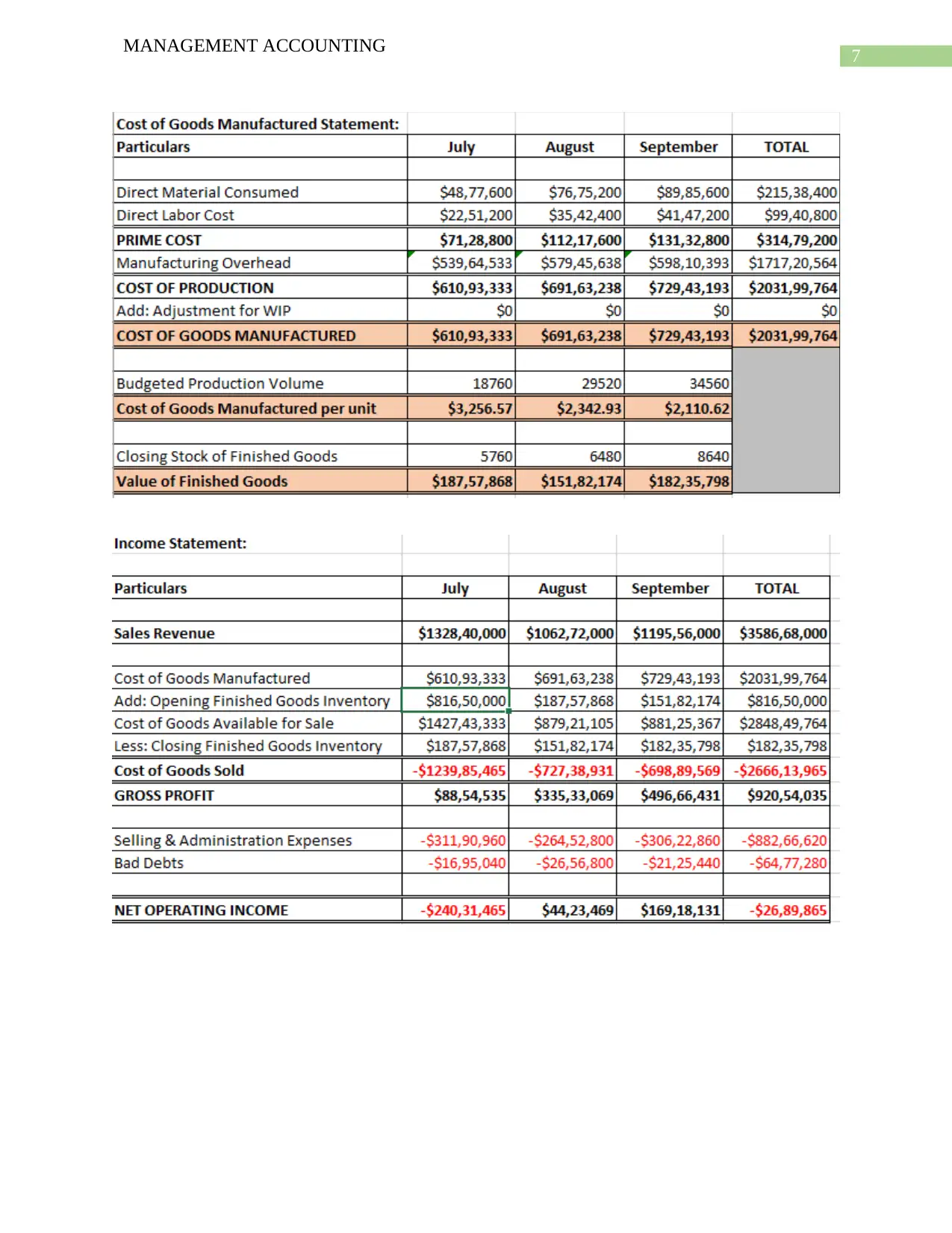
7
MANAGEMENT ACCOUNTING
MANAGEMENT ACCOUNTING

8
MANAGEMENT ACCOUNTING
Part B
Analysis of Production Plan
In the case study which is provided in the question is associated with the business of
Krishnamurti Pty Ltd which is engaged in the production of AC/D C switches which is then used
in solar-powered electricity-generation. The company operates its business in Europe and
Australia. The production manager is planning to introduce a new production site which will
help the management to increase the overall production of the business. The main objective of
the business is to generate as much profits for the business as possible. The new plan of the
management is intended to provide a boast to the production process and further improve the
same. The company in order to check the viability of the project has planned to use master
budgeting approach wherein all budgets are prepared which are in some cases related to
respective departments The various components of master budgets which are prepared by the
management and the same is analyzed as per the cost ands revenue estimates of the business
(Antfolk et al. 2014).
As per the sales budget which is prepared by the management, the sales volume of the
business falls from the month of July and is slighted expected to improve in the month of
October. Thus, keeping the sales price constant, the budgeted sales revenue is anticipated to be
highest in the month of October which does not fall in the quarter for which the selection process
is being applied. The production budget shows that the production volume has increased in the
month of September. The direct labour budget shows that as the production value increases the
direct labour hours which are associated with the budget also rises (Mishra et al. 2014). The total
direct labour hour which is anticipated is shown as 138240 hours and the budgeted direct labour
MANAGEMENT ACCOUNTING
Part B
Analysis of Production Plan
In the case study which is provided in the question is associated with the business of
Krishnamurti Pty Ltd which is engaged in the production of AC/D C switches which is then used
in solar-powered electricity-generation. The company operates its business in Europe and
Australia. The production manager is planning to introduce a new production site which will
help the management to increase the overall production of the business. The main objective of
the business is to generate as much profits for the business as possible. The new plan of the
management is intended to provide a boast to the production process and further improve the
same. The company in order to check the viability of the project has planned to use master
budgeting approach wherein all budgets are prepared which are in some cases related to
respective departments The various components of master budgets which are prepared by the
management and the same is analyzed as per the cost ands revenue estimates of the business
(Antfolk et al. 2014).
As per the sales budget which is prepared by the management, the sales volume of the
business falls from the month of July and is slighted expected to improve in the month of
October. Thus, keeping the sales price constant, the budgeted sales revenue is anticipated to be
highest in the month of October which does not fall in the quarter for which the selection process
is being applied. The production budget shows that the production volume has increased in the
month of September. The direct labour budget shows that as the production value increases the
direct labour hours which are associated with the budget also rises (Mishra et al. 2014). The total
direct labour hour which is anticipated is shown as 138240 hours and the budgeted direct labour
⊘ This is a preview!⊘
Do you want full access?
Subscribe today to unlock all pages.

Trusted by 1+ million students worldwide
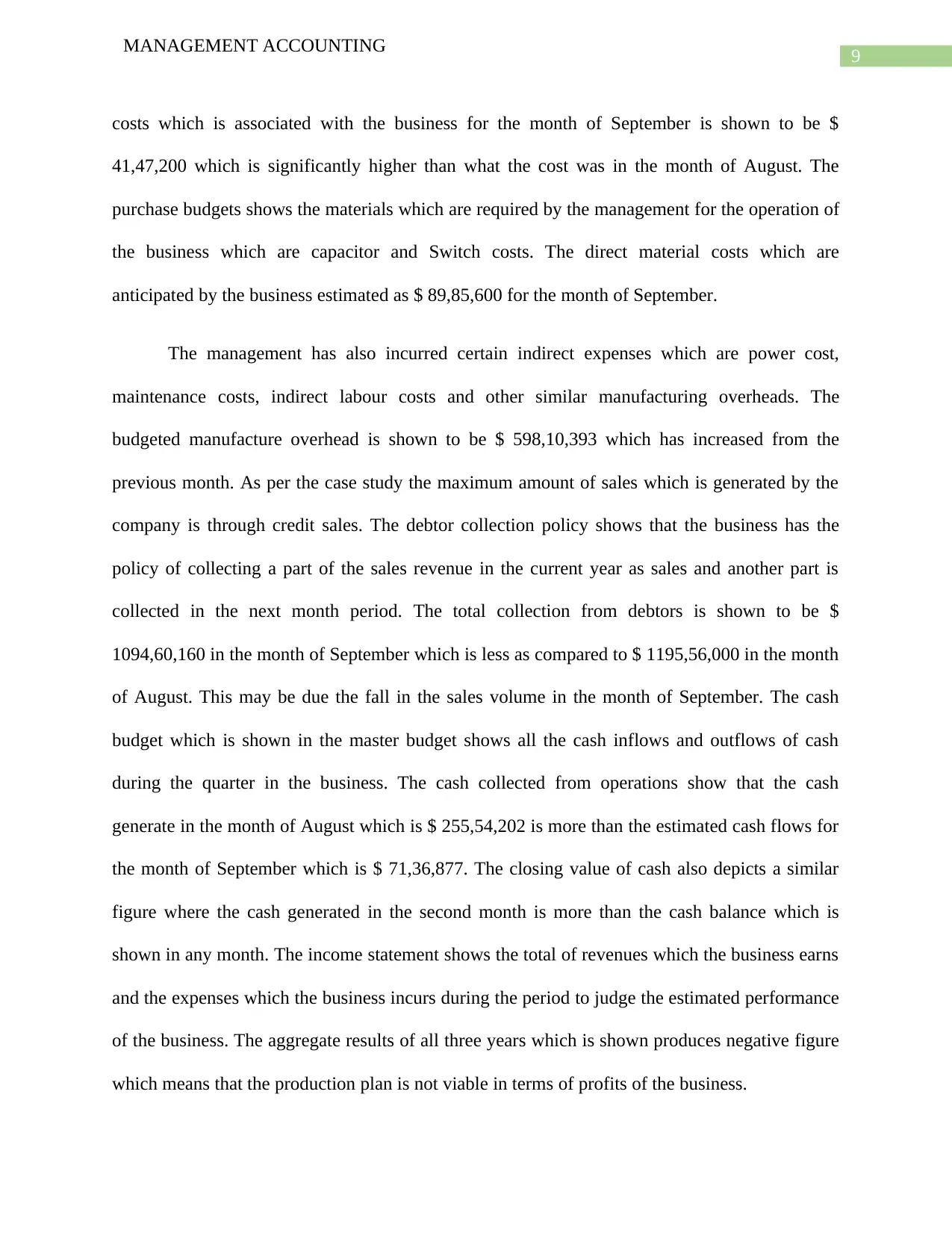
9
MANAGEMENT ACCOUNTING
costs which is associated with the business for the month of September is shown to be $
41,47,200 which is significantly higher than what the cost was in the month of August. The
purchase budgets shows the materials which are required by the management for the operation of
the business which are capacitor and Switch costs. The direct material costs which are
anticipated by the business estimated as $ 89,85,600 for the month of September.
The management has also incurred certain indirect expenses which are power cost,
maintenance costs, indirect labour costs and other similar manufacturing overheads. The
budgeted manufacture overhead is shown to be $ 598,10,393 which has increased from the
previous month. As per the case study the maximum amount of sales which is generated by the
company is through credit sales. The debtor collection policy shows that the business has the
policy of collecting a part of the sales revenue in the current year as sales and another part is
collected in the next month period. The total collection from debtors is shown to be $
1094,60,160 in the month of September which is less as compared to $ 1195,56,000 in the month
of August. This may be due the fall in the sales volume in the month of September. The cash
budget which is shown in the master budget shows all the cash inflows and outflows of cash
during the quarter in the business. The cash collected from operations show that the cash
generate in the month of August which is $ 255,54,202 is more than the estimated cash flows for
the month of September which is $ 71,36,877. The closing value of cash also depicts a similar
figure where the cash generated in the second month is more than the cash balance which is
shown in any month. The income statement shows the total of revenues which the business earns
and the expenses which the business incurs during the period to judge the estimated performance
of the business. The aggregate results of all three years which is shown produces negative figure
which means that the production plan is not viable in terms of profits of the business.
MANAGEMENT ACCOUNTING
costs which is associated with the business for the month of September is shown to be $
41,47,200 which is significantly higher than what the cost was in the month of August. The
purchase budgets shows the materials which are required by the management for the operation of
the business which are capacitor and Switch costs. The direct material costs which are
anticipated by the business estimated as $ 89,85,600 for the month of September.
The management has also incurred certain indirect expenses which are power cost,
maintenance costs, indirect labour costs and other similar manufacturing overheads. The
budgeted manufacture overhead is shown to be $ 598,10,393 which has increased from the
previous month. As per the case study the maximum amount of sales which is generated by the
company is through credit sales. The debtor collection policy shows that the business has the
policy of collecting a part of the sales revenue in the current year as sales and another part is
collected in the next month period. The total collection from debtors is shown to be $
1094,60,160 in the month of September which is less as compared to $ 1195,56,000 in the month
of August. This may be due the fall in the sales volume in the month of September. The cash
budget which is shown in the master budget shows all the cash inflows and outflows of cash
during the quarter in the business. The cash collected from operations show that the cash
generate in the month of August which is $ 255,54,202 is more than the estimated cash flows for
the month of September which is $ 71,36,877. The closing value of cash also depicts a similar
figure where the cash generated in the second month is more than the cash balance which is
shown in any month. The income statement shows the total of revenues which the business earns
and the expenses which the business incurs during the period to judge the estimated performance
of the business. The aggregate results of all three years which is shown produces negative figure
which means that the production plan is not viable in terms of profits of the business.
Paraphrase This Document
Need a fresh take? Get an instant paraphrase of this document with our AI Paraphraser
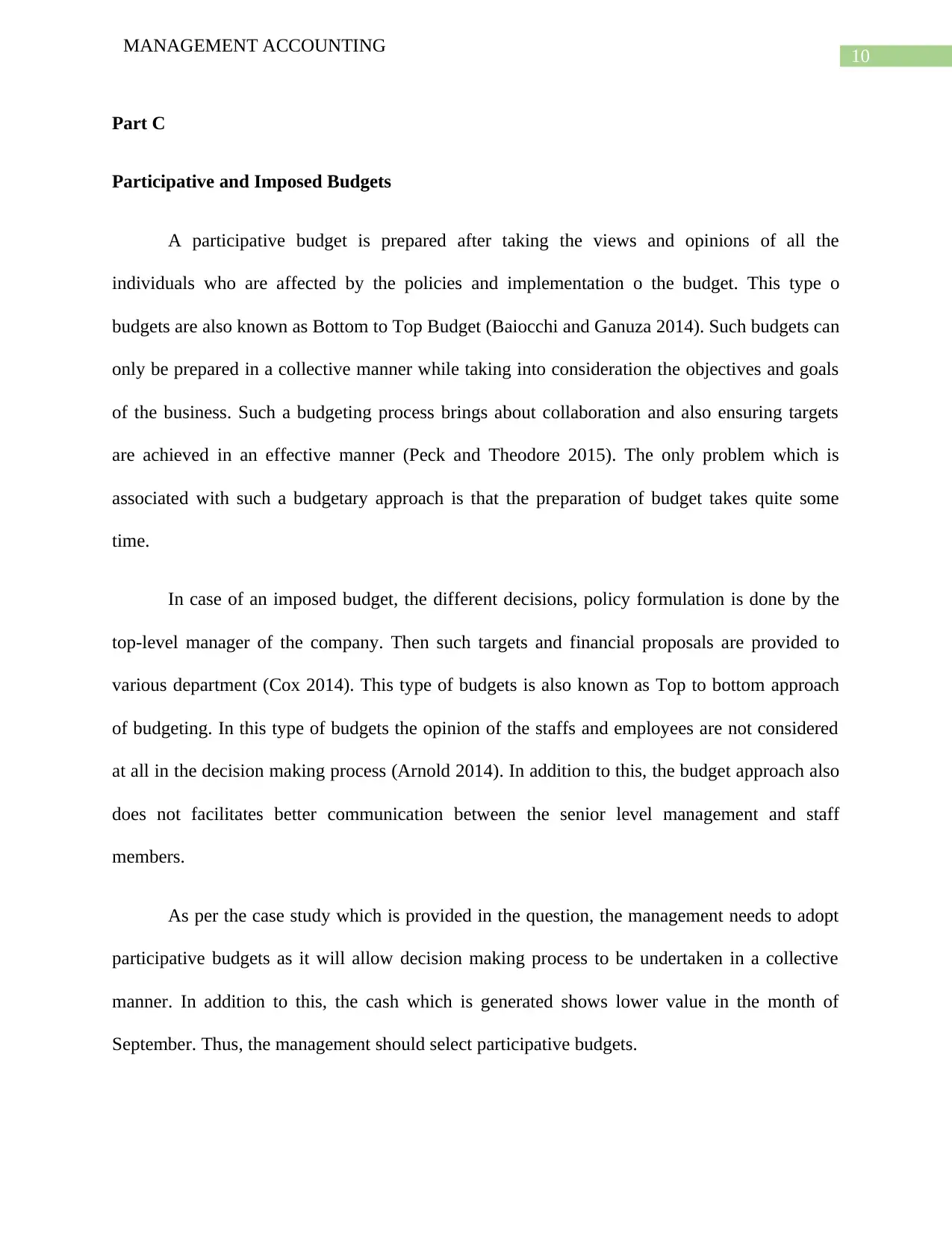
10
MANAGEMENT ACCOUNTING
Part C
Participative and Imposed Budgets
A participative budget is prepared after taking the views and opinions of all the
individuals who are affected by the policies and implementation o the budget. This type o
budgets are also known as Bottom to Top Budget (Baiocchi and Ganuza 2014). Such budgets can
only be prepared in a collective manner while taking into consideration the objectives and goals
of the business. Such a budgeting process brings about collaboration and also ensuring targets
are achieved in an effective manner (Peck and Theodore 2015). The only problem which is
associated with such a budgetary approach is that the preparation of budget takes quite some
time.
In case of an imposed budget, the different decisions, policy formulation is done by the
top-level manager of the company. Then such targets and financial proposals are provided to
various department (Cox 2014). This type of budgets is also known as Top to bottom approach
of budgeting. In this type of budgets the opinion of the staffs and employees are not considered
at all in the decision making process (Arnold 2014). In addition to this, the budget approach also
does not facilitates better communication between the senior level management and staff
members.
As per the case study which is provided in the question, the management needs to adopt
participative budgets as it will allow decision making process to be undertaken in a collective
manner. In addition to this, the cash which is generated shows lower value in the month of
September. Thus, the management should select participative budgets.
MANAGEMENT ACCOUNTING
Part C
Participative and Imposed Budgets
A participative budget is prepared after taking the views and opinions of all the
individuals who are affected by the policies and implementation o the budget. This type o
budgets are also known as Bottom to Top Budget (Baiocchi and Ganuza 2014). Such budgets can
only be prepared in a collective manner while taking into consideration the objectives and goals
of the business. Such a budgeting process brings about collaboration and also ensuring targets
are achieved in an effective manner (Peck and Theodore 2015). The only problem which is
associated with such a budgetary approach is that the preparation of budget takes quite some
time.
In case of an imposed budget, the different decisions, policy formulation is done by the
top-level manager of the company. Then such targets and financial proposals are provided to
various department (Cox 2014). This type of budgets is also known as Top to bottom approach
of budgeting. In this type of budgets the opinion of the staffs and employees are not considered
at all in the decision making process (Arnold 2014). In addition to this, the budget approach also
does not facilitates better communication between the senior level management and staff
members.
As per the case study which is provided in the question, the management needs to adopt
participative budgets as it will allow decision making process to be undertaken in a collective
manner. In addition to this, the cash which is generated shows lower value in the month of
September. Thus, the management should select participative budgets.
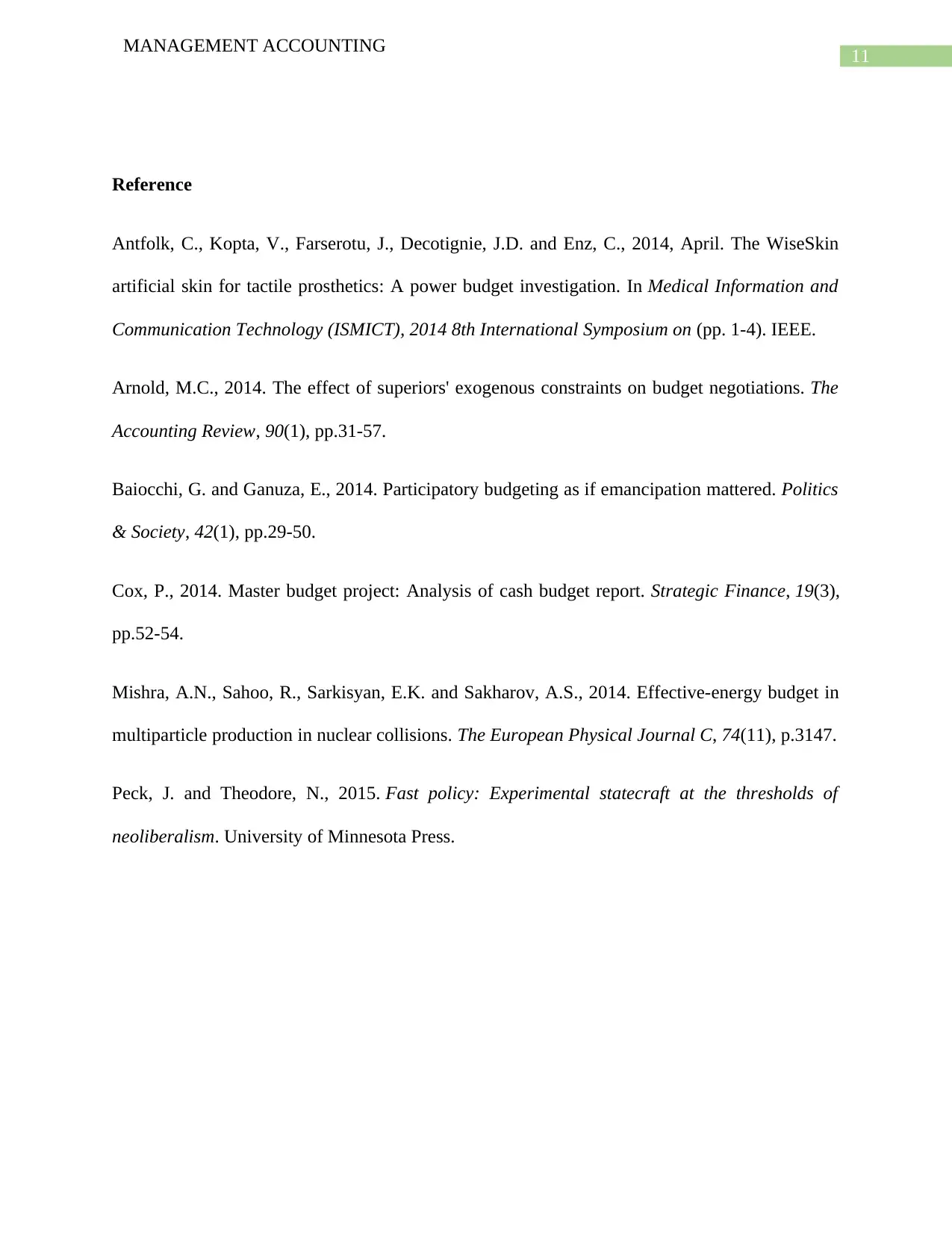
11
MANAGEMENT ACCOUNTING
Reference
Antfolk, C., Kopta, V., Farserotu, J., Decotignie, J.D. and Enz, C., 2014, April. The WiseSkin
artificial skin for tactile prosthetics: A power budget investigation. In Medical Information and
Communication Technology (ISMICT), 2014 8th International Symposium on (pp. 1-4). IEEE.
Arnold, M.C., 2014. The effect of superiors' exogenous constraints on budget negotiations. The
Accounting Review, 90(1), pp.31-57.
Baiocchi, G. and Ganuza, E., 2014. Participatory budgeting as if emancipation mattered. Politics
& Society, 42(1), pp.29-50.
Cox, P., 2014. Master budget project: Analysis of cash budget report. Strategic Finance, 19(3),
pp.52-54.
Mishra, A.N., Sahoo, R., Sarkisyan, E.K. and Sakharov, A.S., 2014. Effective-energy budget in
multiparticle production in nuclear collisions. The European Physical Journal C, 74(11), p.3147.
Peck, J. and Theodore, N., 2015. Fast policy: Experimental statecraft at the thresholds of
neoliberalism. University of Minnesota Press.
MANAGEMENT ACCOUNTING
Reference
Antfolk, C., Kopta, V., Farserotu, J., Decotignie, J.D. and Enz, C., 2014, April. The WiseSkin
artificial skin for tactile prosthetics: A power budget investigation. In Medical Information and
Communication Technology (ISMICT), 2014 8th International Symposium on (pp. 1-4). IEEE.
Arnold, M.C., 2014. The effect of superiors' exogenous constraints on budget negotiations. The
Accounting Review, 90(1), pp.31-57.
Baiocchi, G. and Ganuza, E., 2014. Participatory budgeting as if emancipation mattered. Politics
& Society, 42(1), pp.29-50.
Cox, P., 2014. Master budget project: Analysis of cash budget report. Strategic Finance, 19(3),
pp.52-54.
Mishra, A.N., Sahoo, R., Sarkisyan, E.K. and Sakharov, A.S., 2014. Effective-energy budget in
multiparticle production in nuclear collisions. The European Physical Journal C, 74(11), p.3147.
Peck, J. and Theodore, N., 2015. Fast policy: Experimental statecraft at the thresholds of
neoliberalism. University of Minnesota Press.
⊘ This is a preview!⊘
Do you want full access?
Subscribe today to unlock all pages.

Trusted by 1+ million students worldwide
1 out of 12
Related Documents
Your All-in-One AI-Powered Toolkit for Academic Success.
+13062052269
info@desklib.com
Available 24*7 on WhatsApp / Email
![[object Object]](/_next/static/media/star-bottom.7253800d.svg)
Unlock your academic potential
Copyright © 2020–2025 A2Z Services. All Rights Reserved. Developed and managed by ZUCOL.





